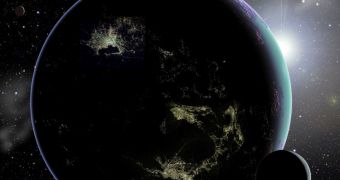Two researchers recently published a new scientific paper, arguing that intelligent lifeforms on other planets could reveal their presence to use through the lights their cities emit. While the proposal has a lot of merit, it's also worth remembering that it operates on an important assumption.
In order for the experts to be correct, the intelligent extraterrestrial would have to use technologies similar to our own. They would also have to live in large cities, capable of generating sufficient light from them to become visible from outer space.
That being said, what the group is proposing is that people engaged in Search for Extraterrestrial Intelligence (SETI) initiatives could orient their efforts towards identifying light pollution emitted from alien cities, since this is most likely one of our giveaways as well.
From the surface of the Moon, Earth's cities are clearly visible on the night side of the planet, and there is no reason to believe that the same does not hold true for aliens living on extrasolar planets as well.
The new paper was authored by Harvard-Smithsonian Center for Astrophysics (CfA) scientist Avi Loeb and Princeton University investigator Edwin Turner. They say that it stands to reason aliens would use artificial illumination similar to our own.
If life on another planet evolved around a star, then it's safe to assume that it is equally dependent to that light as life here on Earth is heavily reliant on the Sun for energy and warmth. As such, any intelligent lifeform would seek to emulate that light artificially.
“Looking for alien cities would be a long shot, but wouldn't require extra resources. And if we succeed, it would change our perception of our place in the Universe,” Loeb explains. However, the expert admits, such small amounts of light would require impressive new telescopes to observe.
The technique the team is proposing is very simple – track the exoplanet as it orbits around its parent star. As the object does this, it undergoes the same phases as our own Moon does, which means that it will successively show us both its night and day sides.
By comparing the amount of light visible from the night side with baseline measurements, astronomers could be able to propose the existence of artificial light coming from the surface of some planet or another.
Turner explains that astronomers could test this new technique on objects closer to home. “It's very unlikely that there are alien cities on the edge of our solar system, but the principle of science is to find a method to check,” he explains.
“Before Galileo, it was conventional wisdom that heavier objects fall faster than light objects, but he tested the belief and found they actually fall at the same rate,” Turner concludes.

 14 DAY TRIAL //
14 DAY TRIAL //